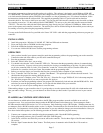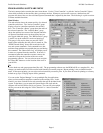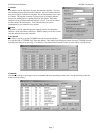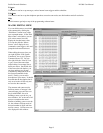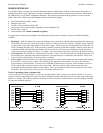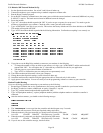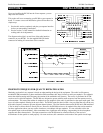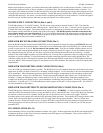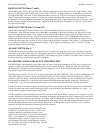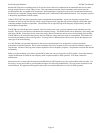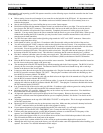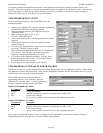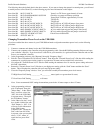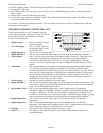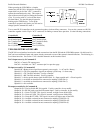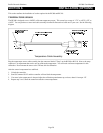
Pacific Research Solutions RI-300e User Manual
Page 13
DIGITAL INPUTS (Pins 6, 7 and 8)
The RI-300 has three digital inputs on board and is currently expandable up to ten, that can be used to trigger macros. These
inputs are C-MOS gates with a voltage swing of 0 to 5 VDC, TTL level. All digital inputs have a 10K ohm pull up resistors.
Your application must “pull down” or sink current with either a transistor or TTL gate or equivalent. Upon detecting either a
rising or falling edge or change in the state of an input, the controller automatically executes a macro. See Section 12,
S-Command 45 and 46 for additional information on programming these inputs. These inputs are located on J1 pins 6, 7 and 8.
See the connector diagram on the previous page. Depending on the squelch mode, S-Command 51, input bit 1 can be used as
an external squelch input.
DIGITAL OUTPUTS (Pins 13, 14 and 15)
The RI-300 has three digital outputs on board and is currently expandable upto ten, whose states can be modified by
S-Commands. Each of the three outputs can be individually commanded or forced into the high or low logic state or pulsed
high for a desired duration of time. These outputs are open collector NPN transistors and can sink up to 120ma each. Each
output has a 10K pull up resistor to 5 volts and can source enough current to drive a TTL or CMOS gate. However these
outputs can sink current from a voltage sources as high as 24 volts. Using S-Commands (or macros that are composed of S-
Commands), each output may be turned on or off or pulsed with the desired S-Commands. See Sections 12 S-Command 46 and
47 for additional information on programming these outputs. These outputs are located on J1 pins 13, 14 and 15. See the
connector diagram on the previous page.
ANALOG INPUTS (Pin 5)
The RI-300 has one analog input that can be directly read as a voltage in the range of 0 to 3.75 volts. This input can also be
connected to your radio's limiter output for a Signal Meter function. In some S-Meter applications, you may need to provide a
method for scaling the voltage connected to this input. When reading this signal over the air, use speech control word 014 for
the analog voltage and speech control word 013 for S-Meter.
DCS DECODE AND ENCODE SET UP AND OPERATION
With DCS (Digital Coded Squelch) decode and encode, you can also select any combination of DCS codes to operate your
repeater. You have 104 standard DCS codes that can be used for decode or encode. The decode codes are selected with
S-Command 20. The encode codes are selected with S-Command 21 and 22. Both CTCSS and DCS will operate together.
The system set up for DCS is the same as CTCSS.
Depending on your repeater, you may have to change the polarity of the DCS TX/RX data. Once you have confirmed that your
radio audio frequency response is correct, you can enable a DCS code for the repeater decode (S-Command 20). When you
send that code to the repeater, check if the CTCSS/DCS LED goes on. If the controller does not decode DCS data, change the
RX polarity (S-Command 25). If your radio will not decode the DCS data from the repeater, change the TX polarity (S-
Command 25). You can also use the programming software to view the current DCS decode to verify the data polarity.
The DCS encode level is remotely adjusted with a digital pot in the same manner as the squelch, except with S-Command 24.
The DCS encoder audio can be mixed with the voice audio or routed directly to the transmitter modulator via J1 pin 11. As
some modulators require a separate input for DCS audio.
CTCSS (Continuous Tone Coded Squelch System) uses continuous tones below 300 Hz. A single tone is assigned for a group
of users. When the tone has been decoded by the repeater, the repeater will pass the users audio. Sometimes two tones next to
each other can become confused with each other. In contrast, DCS uses digital data or code words. Each code word is unique
and all code words may be used on the same channel without interference. At the end of the repeater transmission and 1/2
second before the transmitter un-keys, the controller will encode a 134 Hz tone that serves as a turn off code. For correct
operation, the DCS data should have a FM deviation of 500 to 800 Hz.
Your transmitter and receiver waveforms should closely
resemble the waveform diagram, figure 1. If this is the
condition, then the low frequency response of your
repeater should be adequate. If your waveform resembles
figure 2, your modulator or discriminator does not have
enough low frequency response. Figure 2 was created
with a high pass filter with a corner frequency at about 5
Hz. Even with a cutoff this low, the filter strips vital data
from the digital code word.



